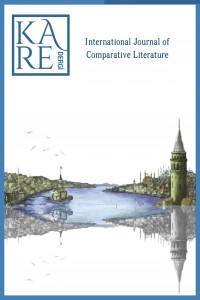Yu-yang Tsa-tsu'nun Derleme Özellikleri ve Türklerle İlgili Rivayetler
Yu-yang Tsa-tsu, türeyiş efsanesi, tercüme
Compilation Features of Yu-yang Tsa-tsu and Narratives on Turks
Yu-yang Tsa-tsu, Turkic legends, translation,
___
- Asanova, Umut. “Philosophy Of Echological Ethics Education, Considering The Issyk-Kul Lake Remediation Mechanisms”. In Lake Issyk-Kul: Its Natural Environment, Nato Science Series: IV. Earth and Environmental Sciences, S.13, ed. Jean Klerkx; Beishen Imanackunov, 2002.
- Cheng Ch’iao 鄭樵. T’ung-chih 通志 (TC). Pekin: Ssu-k'u Ch'üen-shu, 1987.
- Chou, Chih-chung 周致中, I-yü-chih 異域志, Pekin: Ssu-k'u Ch'üen-shu, 1781.
- Duan, Chengshi. Youyang Zazu. Beijing: Xueyuan Chubanshe, 2001.
- Eberhard, Wolfram. A Dictionary Of Chinese Symbols. Routledge, 2006.
- Eberhard, Wolfram. Çin’in Şimal Komşuları. çev. Nimet Uluğtuğ. Ankara: Türk Tarih Kurumu, 1996.
- Erkoç, Hayrettin, İhsan, "Türk Mitlerindeki Motifler (VI.-VIII. Yüzyıllar), Journal of Old Turkic Studies, Vol. 1/1 (winter) 2017, s. 36-75.
- Erkoç, Hayrettin İhsan, "Çin ve Tibet Kaynaklarına Göre Göktürk Mitleri, Belleten Cilt: LXXXII Nisan 2018. s. 51-83.
- Erkoç, Hayrettin İhsan, "Efsanevi Türk Hükümdarı Yama Kağan ve Türk Mitolojisinde Fatih Ata Motifi", 9. Milletlerarası Türk Kültür Kongresi: Gelenek Görenek ve İnançlar, Ordu: 2017.
- Ferguson, John Calvin and Anesaki, Masaharu. The Mythology Of All Races: Chinese- Japanese, C.8. Boston: Marshal Jones Companys, 1916.
- Halbertsma, Tjalling. “Some Field Notes and Images of Stone Sculptures Found at Nestorian Sites in Inner Mongolia”, Hidden Treasures and Intercultural Encounters. Ed. Winkler, W. Dietmar; Li, Tang. Berlin: Orientalia-Patristica-Oecumenica, 2009, 52.
- Hawkes, David. The Songs Of The South. Londra: 2011.
- Kao, Karl, S. Y. “Projection, Displacement, Introjection: The Strangeness of Liaozhai Zhiyi,” Paradoxes of Traditional Chinese Literature. Hong Kong: Chinese Uni. Press, 1994.
- Kapusuzoğlu, Gökçen. Taiping Derlemesinde Türkler..Ankara: Gece Kitaplığı, 2017.
- Karl, S. Y. Kao. “Projection, Displacement, Introjection: The Strangeness of Liaozhai zhiyi,” Paradoxes of Traditional Chinese Literature, Hong Kong, 1994.
- Li, Yanshou 李延壽. Pei Shih 北史 (Kuzey Tarihi). Pekin: Chung-hua Shu-chü, 1988.
- Lin, Ti-chih 凌迪知. Wan-hsing T'ong-p'u万姓统谱. Pekin: Ssu-k'u Ch'üen-shu, 1758.
- Ling-hu, Te-fen令狐德棻, Chou Tarihi周書. Pekin: Chung-hua Shu-chü, 1988.
- Liu, Hsün 劉昫. Chiu T'ang Shu舊唐書 (Eski T'ang Tarihi). Pekin: Chung-hua Shu-chü
- Ou-yang, Xiu 歐陽修, Hsin T'ang Shu 新唐書 (Yeni T'ang Tarihi). Pekin: Chung-hua Shu-chü, 1975.
- Ögel, Bahaeedin. Türk Mitolojisi, C.1. Ankara: Türk Tarih Kurumu, 2014.
- Reed, Carrie E. “Motivation and Meaning of a ‘Hodge-podge’: Duan Chengshi’s Youyang Zazu”, The Journal of the American Oriental Society, S. 123 (1), 2003.
- SK. Lim. Origins Of Chinese Auspicious Symbols. Singapur: Asiapac Books Pte Ltd, 2012.
- Shen, Yüeh (沈約). Sung, Shu (宋書, Sung Tarihi,). Pekin: Chung-hua Shu-chü, 1974, 28.
- Ssu-ma, Ch'ien 司馬遷. Shih-chi史記 (Tarihçinin Kayıtları). Pekin: Chung-hua Shu-chü, 1986.
- Sinor, Denis. “The Legendary Origin Of The Türks”. In Folklorica: Festschrift For Felix J. Oinas, Ed. Egle Victoria Zygas; Peter Voorheis, Bloomington, Indiana: Indiana University Press, 1982.
- Tai, Liang-tso 戴良佐. Hsi-yü Pei-ming Lu 西域碑铭录 (Batı Bölgeleri Yazıt Kayıtları). Urumçi: Hsing-chiang Jen-min Ch’u-pan-she, 2013.
- Tuan, Ch’eng-shih (段成式). Yu-yang Tsa-tsu Cheng Hsü-chi 酉陽雜俎正續集. Shanghai: Sao-yeh Shan-fang, 1931.
- Tuan, Ch’eng-shih (段成式). Yu-yang Tsa-tsu Cheng Hsü-chi 酉陽雜俎. Pekin: Si-k'u Ch'üen-shu, 1781.
- Xiao, Haibo 肖海波. Liuchao Zhiguai Xiaoshuo Xuanze 六朝志怪小说选择, ed. Luo, Shaoqing 罗少卿. Nanjng: Fenghuang Chubanshe, 2011.
- Wang, Lin. Celebration Of The Strange: Youyang Zazu And Its Horror Stories, Yayımlanmamış Doktora Tezi, Georgia: 2012.
- Wang, Pu 王溥. T’ang Hui Yao 唐會要. Pekin: Ssu-k'u Ch'üen-shu, 1955.
- Wu, Kang 吳鋼. Ch’üan T’ang Wen Pu-i 全唐文補遺 (Tang Metinleri Derlemesine İlaveler), C. 6, Hsi-an: 1999.
- Yamada, Nobuo, Folklorica: Festschrift For Felix J. Oinas, Ed. Egle Victoria Zygas; Peter Voorheis, Bloomington, Indiana: Indiana University Press, 1982.
- Yang, Lihui, An, Deming, Turner, Jessica Anderson. Handbook Of Chinese Mythology, California: ABC Clio, 2005.
- Yü, Yin 余寅, T’ung-hsing-ming Lu同姓名錄, Pekin: Ssu-k'u Ch'üen-shu, 1756.
- Yüan, Ko 袁珂. Shan-hai-ching Chiao-chu 山海經校註 (Dağlar ve Denizler Klasiği Üzerine Karşılaştırmalı Notlandırmalar). Shanghai: Chung-hua Chi-liang Ch'-pan-she, 1980.
- ISSN: 2536-4596
- Yayın Aralığı: Yılda 2 Sayı
- Başlangıç: 2016
- Yayıncı: Hasan BAKTIR
Yu-yang Tsa-tsu'nun Derleme Özellikleri ve Türklerle İlgili Rivayetler
Gürhan KİRİLEN, Melike KIRİLEN
Mahābhārata’da Evlilik ve Kadının Konumunun Biyo-İktidar Kuramı Bağlamında Değerlendirilmesi
Turkish Grammar Equivalent of Negation Adverbs '안/an/' and '못/mot/' in Korean
S.göksel TÜRKÖZÜ, Sibel SÖĞÜTLÜ
